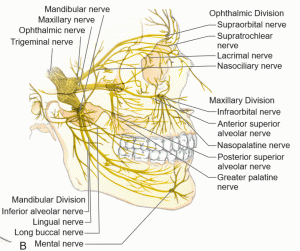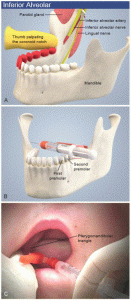So you’re working your pediatric shift again and you see a child who fell and hit his chin on a table and now has a tongue laceration which you’ve deemed needs repair (see prior post for criteria). How are you going to anesthetize the area in order to get the most comfortable procedure possible? Below are some techniques to have in your arsenal:
Topical Anesthesia – Due to the mucosal surface you’ll be working with a topical approach can sometimes work well. It is important to dry the area as much as possible and then placing a swab/gauze soaked in 4% lidocaine for about 5 minutes. Drying will ensure that not as much of the lidocaine is carried off with the saliva.
Infiltration Anesthesia – This is the technique most people are comfortable with and is done for majority of other lacerations. You can use lidocaine 1-2% with epinephrine with a syringe and needle and inject the amount needed into the tissues surrounding the laceration. Epinephrine will help increase the duration of the anesthesia effect as well as decrease local bleeding and is safe for application into the tongue. This technique can be useful if the topical application has failed or is not possible, but with more complex lacerations this can lead to multiple injections to get an effective coverage of anesthesia. For those lacerations you should do:
Regional Anesthesia/Nerve Block – The anterior 2/3 of the tongue is innervated by the lingual nerve and can be anesthetized using the same technique as an inferior alveolar nerve block due to its close proximity as can be seen in the figure below. A block in this area, when done correctly, will provide anesthesia for all the teeth on that side of the mandible and usually lower lip and chin as well as the tongue. This procedure involves finding your landmarks, namely the coronoid notch, and directing your needle towards the nerve. It is important to angle correctly and continue to advance the needle until you hit bone in order to know you are in the right area. The lingual nerve can be anesthetized by injecting as you withdraw the needle from that space. Lidocaine with epi or better yet bupivacaine can be used for this. Remember to topically anesthetize the mucosal surface before starting to keep the patient more comfortable during the injection. A full video on instructions can be found here for a more detailed look.
Bottom Line: Proper anesthesia will make this (and any) laceration repair more comfortable for you and your patient. And a little versed probably wouldn’t hurt either.
References:
Roberts, James R., et al. Roberts and Hedges’ Clinical Procedures in Emergency Medicine and Acute Care. Elsevier, 2019.
FreeDentalEducation. “Mandibular Anesthesia – Inferior Alveolar Nerve Block.” YouTube, YouTube, 15 Mar. 2013, www.youtube.com/watch?v=kmPqV-dMo98.


